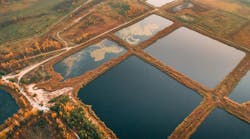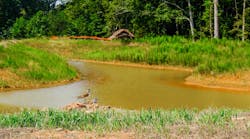Sediment captured in construction site storm water runoff is one of the most widespread pollutants affecting rivers and streams. One method of preventing sediment runoff is capturing it in a sediment basin, which must include certain features to be effective.
Many traditional sediment basin designs use a perforated riser pipe as the primary outlet structure, but inspections following rainfall events have revealed that perforated riser pipes do not allow sediment-laden storm water to be detained for a sufficient period of time.
A field-scale data collection plan to monitor and evaluate the performance of a sediment basin design was developed and implemented on a highway construction site in Franklin County, Ala. It was monitored over the course of 16 rainfall events between Nov. 15, 2011, and Feb. 6, 2012. The design configuration consisted of a Faircloth Skimmer surface drain as the primary dewatering device, three coir baffles installed inside the basin, polyacrylamide flocculant blocks and ditch checks in the inflow channel.
The basin design effectively removed sediment during the early stages of construction—approximately 97.9% of sediment removal after a rainfall event. In the first 12 hours of the dewatering process, the skimmer prevented the discharge of turbid water that contained heavy sediment.
In order to maximize efficiency, a basin needs to incorporate key elements—proper sizing and shape, baffles, skimmer, and, when feasible, flocculants to remove sediment.
“Stormwater Field Evaluation and Its Challenges of a Sediment Basin with Skimmer and Baffles at a Highway Construction Site” offers further details of the research. The research was conducted by Xing Fang, Wesley C. Zech and Christopher P. Logan.






